Curious Kids – Q & A
These questions and answers were originally published in Curious Kids, a series for children appearing in The Conversation.
Question 1: Do butterflies remember being caterpillars?
We have caterpillars at home. I would like to know whether they will remember being caterpillars when they are butterflies. – Evan, age 5, Bristol, UK.

Question 1 Answer
Michael F. Braby, Australian National University, responds to the question
Dear Evan,
I think it is highly unlikely that a butterfly or moth remembers being a caterpillar. However, it may well remember some experiences it learned as a caterpillar.
That fact in itself is especially amazing because inside the pupa (or chrysalis), the caterpillar actually turns to liquid as it transforms into a butterfly or moth (the adult stage).
The transformation from the pupa to the adult is the most dramatic change in the life cycle of a butterfly, and scientists refer to this change as metamorphosis. During metamorphosis, the body tissues of the caterpillar are completely reorganised to produce the beautiful adult butterfly that emerges from the pupa.
Scientists have known for a long time that caterpillars can learn and remember things when they are caterpillars, and adult butterflies can do the same when they are butterflies. However, because of metamorphosis, we were not sure if an adult butterfly could remember things it learned as a caterpillar.
This ability to remember caterpillar experiences as an adult was tested in a study by a team of scientists at Georgetown University in the US.
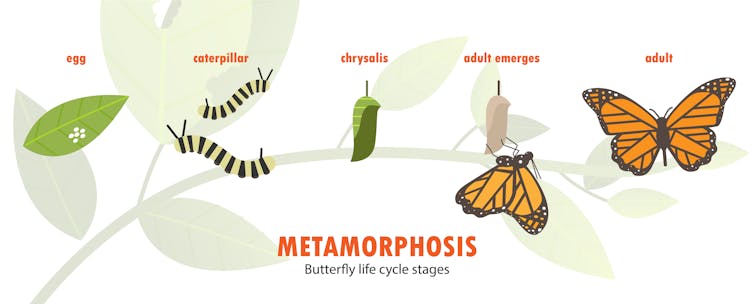
The researchers trained the caterpillars to dislike the smell of ethyl acetate, a chemical often found in nail polish remover.
They did this by giving the caterpillars little electric shocks every time they smelled the chemical. Soon, these caterpillars were trained to avoid that smell because it reminded them of the electric shock.
They let the caterpillars transform into adult moths, and then tested the moths again to see if they still remembered to stay away from the ethyl acetate smell.
And guess what? Most of them did! The scientists had shown that the memories of avoiding the bad smell experienced as a caterpillar had been carried over into the moth stage.
The study showed that memory, and therefore the nervous system, stays during the complex transformation from the caterpillar to the adult moth. So while a moth or butterfly may not remember being a caterpillar, it can remember experiences it learned as a caterpillar.
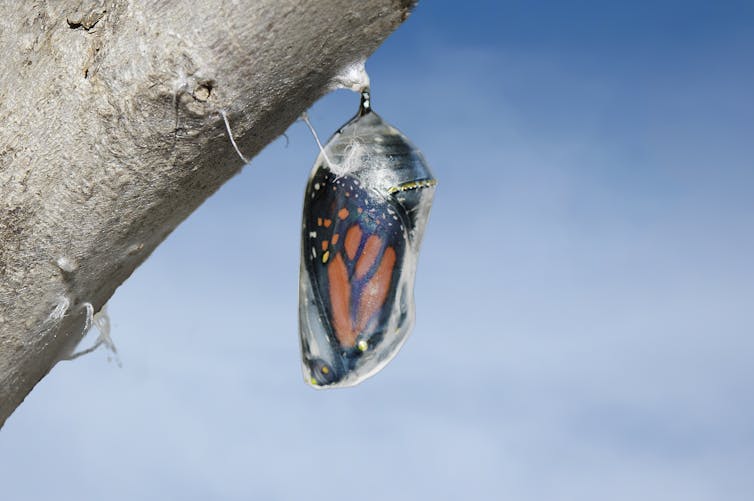
More weird and wonderful butterfly facts
The main purpose of a caterpillar’s life is to eat food and grow bigger. The adult butterfly or moth, however, is mostly concerned with finding a mate, flying to a new area and searching for suitable plants on which to lay its eggs.
Most caterpillars eat leaves of plants, but some eat other foods like flowers or fruits. Some eat very strange foods, such as ants or insects.
Dr Daniel Rubinoff, a scientist who studies butterflies and moths, recently reported a very unusual diet from Hawaii. The caterpillar of a particular species of moth ate only the soft tissue of a snail!.
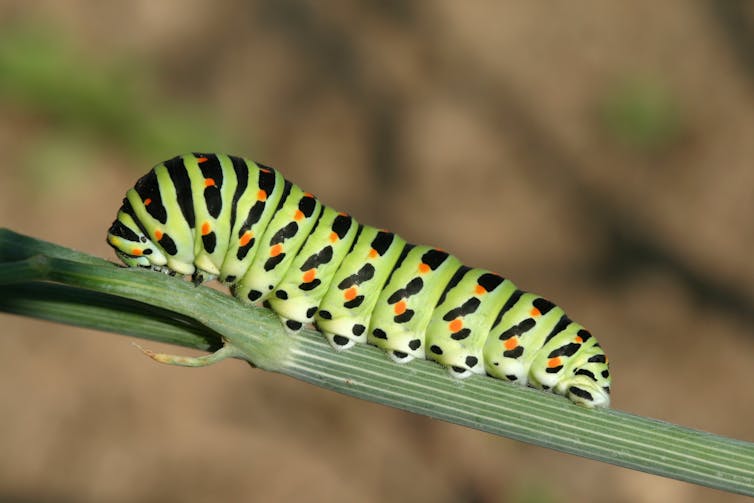
Unlike a hungry caterpillar, which grows quickly and increases in size, the adult butterfly never grows. It always stays the same size.
However, for the butterfly to survive and live long enough to mate and lay eggs, it must drink. The favoured drink for butterflies is nectar from flowers, which is rich in sugars to give energy. But some butterflies also drink the moisture from sand, especially along the banks of creeks or rivers.
A few species in the tropics even drink the moisture from rotting fruit or animal poo to extract essential nutrients.
Thank you for sending in this very interesting question.
Yours sincerely,
A/Prof Michael F. Braby
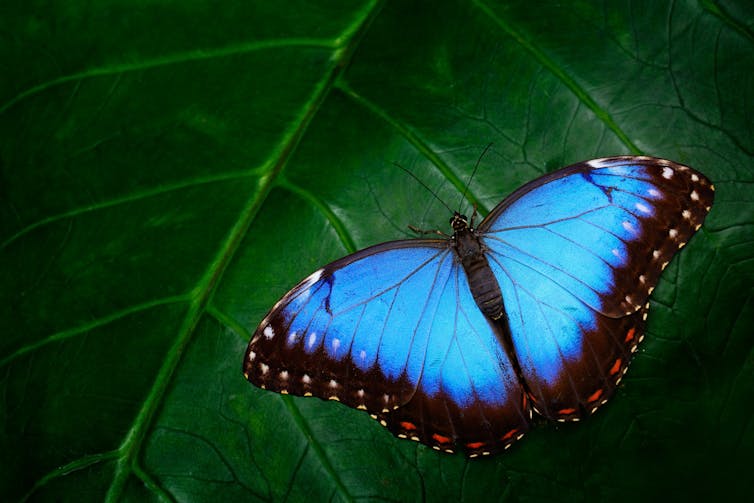
Michael F. Braby, Associate Professor, Australian National University
This article was originally published on The Conversation. Read the original article.
Question 2: What are Spiders webs made from and how strong are they?
My name is Leo. I am 5 years old and I live in Sydney. My question is: what are spider webs made from and how strong are they? – Leo, 5, Sydney.

Question 2: Answer
Spider webs are made from silk. And silk is made from something scientists call “proteins”.
Proteins are special chemicals made by a living thing – like an animal or a plant. You have lots of them in your body. Proteins usually have a certain job to do.
Some join together to make something bigger. Your hair and your nails are made of proteins (they are both made by a protein called “keratin”).
Insects and spiders make silk in a special part of their body called a gland, and use their legs to pull it out of their bodies. This is called spinning.
Most species of spider have more than one kind of silk gland. Each one has different strength and stretchiness and is used for a specific purpose such as web frame, sticky strands, or covering eggs. The strength and stretchiness of silk depends on the way the spider’s body arranges the silk proteins.
Spiders have evolved to spin very strong silk webs so they can catch insects to eat. This means that long ago, spiders that made stronger webs caught more insects to eat and had more babies, but spiders that made weaker webs caught fewer insects and had fewer babies.
After millions of years of this process, some spiders today make silk that is very strong. We don’t usually notice just how strong they can be because they are amazingly thin. But the strongest silk, such as silk from a golden orb spider, is actually stronger than steel. Even more amazing, it is about 50 times as light.
Actually, spider silk is a bit like a cross between steel and rubber. Even with the help of complicated machines and chemicals, humans still don’t know how to make a material this strong, stretchy, and light. Spiders are still the champions at this.
Amazing facts about silk
Most people know that spiders and silkworms make silk, but did you know there are more than 20 different groups of animals that make silk?
Silk-making animals include crickets, silverfish, glow-worms, ants, bees, wasps, flies, caterpillars, lacewings, and sawfly larvae.
Some of these make silk to protect themselves. Crickets, for example, use silk to sew leaves together to build a nest. Others use silk in mating, such as dance-flies, in which the male impresses the female with a gift of food wrapped in silk. Some use silk for hunting, such as spiders and even glow-worms, which use sticky silk to capture flying animals they’d like to eat.
Scientists are closer than ever to producing artificial silk. For example, Dr Tara Sutherland at CSIRO Ecosystem Sciences can make bee silk proteins using bacteria, and then spin them into solid strings similar to those made by bees.
Maybe one day, if you become a scientist, you might be able to make something as strong, as light and as special as spiders’ silk.
Question 3 How do bees make honey?
How do bees make honey? Finn, age 7, Sunshine Coast, Queensland
Question 3 Answer
Hi Finn, that’s a sweet question!
Well, when we talk about “bees”, we’re usually referring to the European honey bee (its scientific name is Apis Mellifera). Humans have been drooling over its honey and taking advantage of its pollination powers for thousands of years.
So how do these insects make honey, you ask? You’ll find the task is one requiring teamwork and organisation.
Busy buzzing bees
You probably already know about the most important ingredient needed to make honey: flowers.
A colony of bees can visit up to 50 million flowers each day, with as many as 60,000 bees in each colony. They’re not called busy bees for nothing!
Honey bees work together as a team to make decisions about where the best flowers are. They communicate with each other using bumps, noises and even dance moves known as the waggle dance.
All bees during their life have different roles, depending on how old they are. To make honey, worker honey bees fly up to 5km searching for flowers and their sweet nectar. Usually, they’ll visit between 50 and 100 flowers per trip.
Nectar is the main ingredient for honey and also the main source of energy for bees. Using a long straw-like tongue called a proboscis, honey bees suck up nectar droplets from the flower’s special nectar-making organ, called the nectary.
When the nectar reaches the bee’s honey stomach, the stomach begins to break down the complex sugars of the nectar into more simple sugars that are less prone to crystallization, or becoming solid. This process is called “inversion”.
Once a worker honey bee returns to the colony, it passes the nectar onto another younger bee called a house bee (between 12-17 days old).
House bees take the nectar inside the colony and pack it away in hexagon-shaped beeswax honey cells. They then turn the nectar into honey by drying it out using a warm breeze made with their wings.
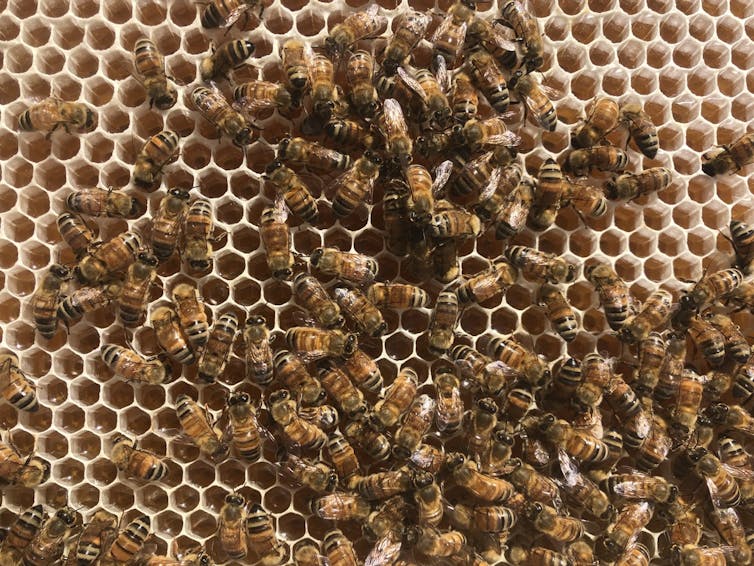
Once the honey has dried out, they put a lid over the honey cell using fresh beeswax – kind of like a little honey jar. In the winter, when the flowers have finished blooming and there’s not as much nectar available, the bees can open this lid and share the honey they saved.
Honey: a food fit for all workers, human and bee
Because nectar comes from flowers, there are hundreds of different types of honey with different colours, smells and flavours. Some honey can even be used as medicine.
Also, bees don’t just collect nectar to make honey. When they visit flowers, they also collect pollen – which is a great source of protein to keep them healthy and strong.
Pollen is a kind of powder which flowering plants, trees and grasses make (and must spread) to help more of the same plants grow around them. Pollen can spread in ways such as being blown around by the air, or being carried between two of the same plant by an insect.
So by transferring pollen between flowers, bees also help pollinate flowers. These often turn into the seeds of the fruit and nuts we eat. In fact, about one-third of the food we eat is pollinated by bees.
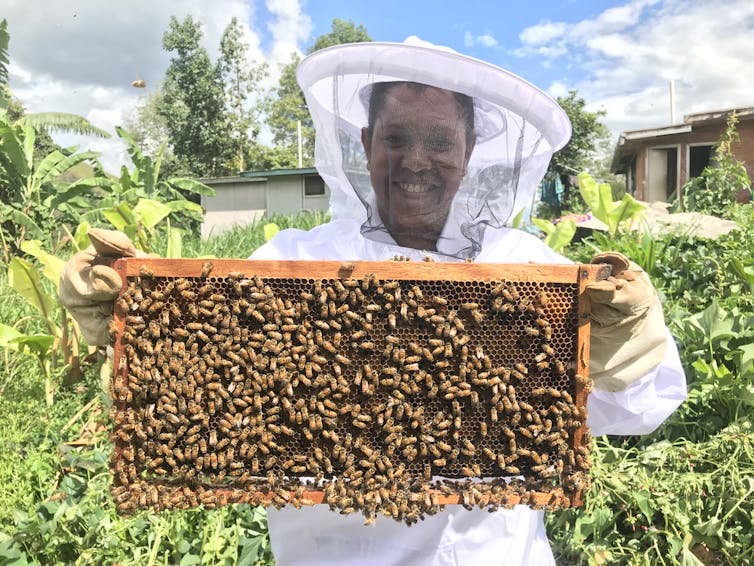
Pollinators around the globe
Did you know the yellow fuzzy honey bee is just one of over 20,000 bee species in the world? There are more than 1,700 in Australia alone, some of which can make honey.
Some native stingless bees only found in Australia, such as Tetragonula carbonaria and Austroplebeia australis, produce honey too.
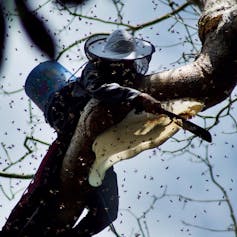
There are also ten other honey bee species overseas, such as the giant honey bee (Apis dorsata) in Nepal and Indonesia, which live at the top of high cliffs and large trees.
There’s also the Eastern honey bee (Apis cerana) which is managed by beekeepers in rural and remote areas throughout Southeast Asia.
There’s never been a better time to put in native flowering plants and stop to smell the flowers. It’s important to remember, just like your puppy or kitten, bees need to be looked after too.
Andrew Walker, Postdoctoral Research Fellow, The University of QueenslandThis article was originally published on The Conversation.
